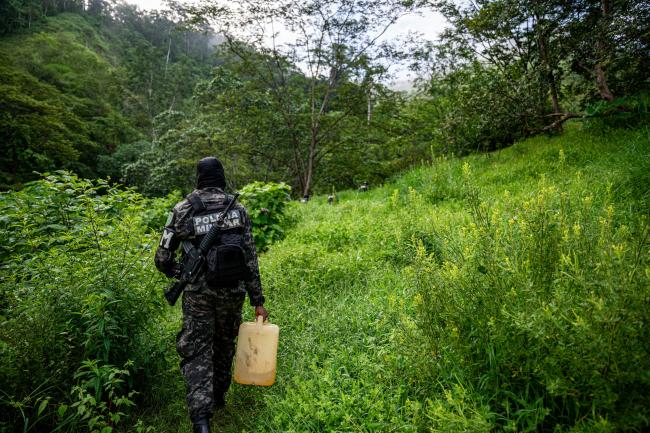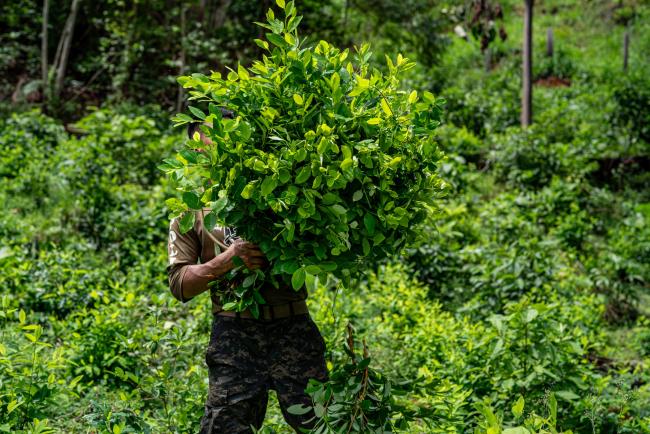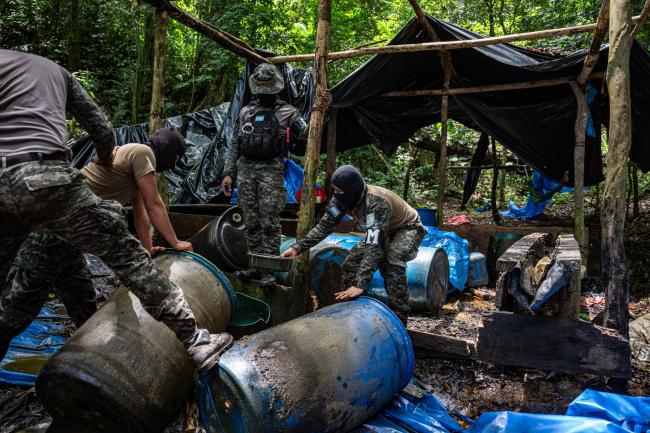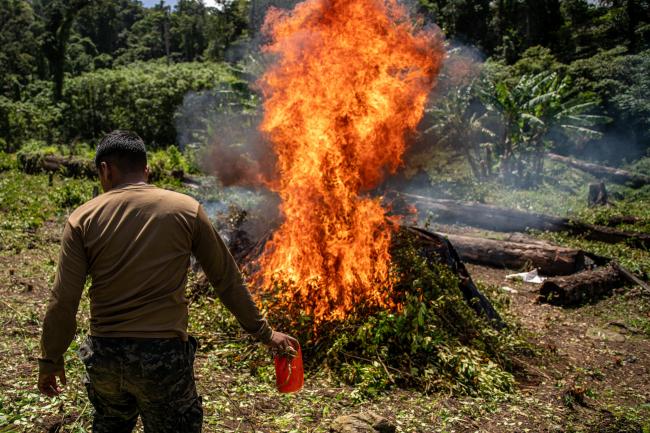
“We have to extinguish the issue before it goes out of control,” says Lieutenant Colonel Medardo Reyes Pego as he walks the narrow halls of Honduras’ headquarters for military intelligence. He’s about to convene a briefing of all the agencies involved in the country’s coca eradication operations. Reyes continues: “We want to keep them confused and scared that we can raid their coca operations any day, hour, and place.”
The group has been busy. Since eradication efforts intensified in 2017, the Honduran military has eradicated millions of coca bushes in an effort to reduce the steep increase of coca-growing operations in the region and the violence that accompanies expanding drug trafficking routes. The raw ingredient used to make cocaine, coca has historically been grown in semi-tropical areas of the South American Andes.
The expansion of coca production in Central America has been exponential. In 2022, more than 6.5 million coca plants were destroyed in Honduras and 4 million in Guatemala, along with a plantation of more than half a million plants in southern Belize. So far in 2024, nearly twice as many coca plantations have been identified and destroyed in Honduras compared to the previous year, and a record number of processing labs have been destroyed in Central America more widely. As opposed to traditional coca-growing operations in the Andes, where small-scale farmers produce most of the crop, in Central America coca cultivation is conducted by organized crime groups under the tutelage and protection of large foreign cartels.
The rapid expansion of coca cultivation—and subsequent cocaine processing—in Central America has caught many observers off-guard. Coca is a crop so long associated with the Andean region that its commercial production in Central America raises a host of questions about shifting drug trafficking dynamics and the future of cocaine production on the isthmus. Are these plantations “experimental,” or can this quintessentially Andean crop thrive outside of its native range? What inspired criminal groups to start growing coca in Central America, given widespread rates of over-production in South America? And what policy interventions might speed or slow coca’s illicit l establishment in Central America?
In September, I joined the Honduran Military Intelligence units on their coca eradication operations deep within the department of Colón to get a better understanding of the scope and challenges on the ground. So far, authorities appear to be focused on eradicating crops rather than criminalizing the growers themselves. “We have strict orders not to mess with the campesino population for political reasons,” a military intelligence officer who wishes to remain anonymous told me. But when trafficking networks infiltrate rural communities, the lines can easily become blurred.

The Research
A research study published last month in Environmental Research Letters provides some insight into these dynamics. Using data on coca’s range in Colombia and matching that with the soil and climate conditions prevalent in Central America, the research team has estimated what parts of Central America have the “right” agroecological conditions for growing the same types of coca that currently thrive in Colombia. According to lead author and land change scientist Paulo José Murillo Sandoval, “The clusters of coca farming in Colombia are well-known... and they can be used to predict and identify other locations where coca is suitable for growing.”
The study’s results are sobering. It turns out that 49 percent of Central American soils have environments that suit coca very well. This indicates that the smattering of coca plantations found so far in Honduras, Guatemala, and Belize are not anomalies or reliant on particular microenvironments. They instead signal a basic fact: coca is a generalist shrub and varieties developed in Colombia are likely to do well in analogous environments in northern Central America.
One of the researchers on the study, geographer Kendra McSweeney, said the results contradicted drug enforcement discourse. “We have heard repeatedly from law enforcement officials that Central America is not suitable for coca production,” she said in an interview. McSweeney and her team worry about the implications of these findings for peace and security in the region. “By saying that coca could be grown more widely in Central America, people dedicated to upholding this tired war on drugs will say, ‘see, Central America is a lawless place full of criminals and it needs more law and order, more military, more Black Hawk helicopters…,’” says McSweeney, referencing the dark history of U.S. intervention in the region.

As evidenced by the growing prevalence of coca cultivation on the isthmus, both drug trafficking groups and the U.S. Drug Enforcement Agency (DEA) already benefit from this knowledge. “They [the cartels] have some of the best coca agronomists in the world. They already know where coca can grow,” notes McSweeney. “And the DEA regularly samples all coca-growing areas. So our results are no surprise to them.” The research team hopes to make this information publicly accessible to allow the civilian population and civil society groups to respond adequately to the shifting dynamics in their territory.
The Balloon Effect
To understand the role of Central America in the drug market, I consulted Oscar Estrada, a Honduran writer and journalist. He is an expert on organized crime in Honduras and author of Tierra de Narcos: cómo las mafias se apropiaron de Honduras (Land of the Narcos: how the mafias appropriated Honduras), which analyzes the tight relationships between drug traffickers and politicians.
“First of all, the drug market changes rapidly and mutates constantly.,” he says emphatically, adding that Central America does not have cartels with the same level of organization and power as neighbouring Mexico, for example. The larger criminal networks that do exist and operate in Central America are mainly working with Mexican or Colombian cartels, as a means for these more powerful groups to outsource routes and trafficking efforts.
According to Estrada, there are two principal factors that have caused the expansion of coca production to Central America. First, the availability of vast areas that are far out of reach of the government and systemically neglected allows for undisturbed deforestation and land grabbing for illegal activities. This is particularly the case in fairly remote Honduran regions, such as La Mosquitia, Olancho, and Colón, where illegal deforestation for drug-related operations has been occurring for more than three decades.

Secondly, Estrada highlights strategies related to the war on drugs, such as the installation of new Israeli aircraft radar systems in 2016, replacing the outdated and widely inoperational analogue radar systems Honduras previously relied upon. This move hindered transnational drug trafficking operations, especially by air, meaning the drug business had to adapt to make the commodity chain more efficient. “Starting the commodity chain in Central America instead of the Andes makes the costly shipping routes obsolete. Suddenly, you don't have to pay off customs, the Army, Navy, and Air Force in five nations anymore since these are no longer on your route,” Estrada notes.
The war on drugs and the restrictions on the products needed to produce cocaine have forced the cartels to look for new areas to produce at a lower cost, both human and financial. This dynamic is classically known as the “balloon effect,” which explains the relationship between law enforcement crackdowns and the displacement of the drug economy: the application of pressure to drug trafficking in one area simply shifts operations to an area where the pressure is lower. Thus, the war on drugs perpetuates a seemingly never-ending cycle of violence and displacement. “The instability we are currently seeing in Colombia, partly due to failing peace talks, and in Ecuador, as a result of the war on gangs, has had massive consequences for the cartels in the north,” Estrada explains. “Crackdowns have made trafficking more and more costly and complicated. So starting the production in Central America reduces costs and risks significantly.”
Indigenous and Rural Communities in the Crossfire
The current strategy employed by the Honduran Armed Forces resembles the early days of the infamous “Plan Colombia,” one of the largest operations of the drug war that spiralled Colombia into a bloody decade of corruption, violence, and displacement. Working with a network of informants, the military attempts to use the advantage of surprise to forcibly eradicate coca operations.
I asked Reyes if he foresees a Central American version of Plan Colombia. “We have still not used fumigation as a tactic, but it's being debated” he replied. According to the Honduran high command, it is necessary to come down hard on these operations in order to hinder the spread of the crop.

The soldiers tasked with the mission are less optimistic about the future of coca eradication in Honduras. “At the rate we are going we have found maybe 5 to 10 percent of the plantations in Honduras,” the military intelligence officer told me. He argues that social programs must accompany eradication efforts that target rural poverty and the financial incentives to grow illicit crops. “If we just roll in there and take away what they have built with nothing to replace it, [the coca crops] will just continue," said the officer. “We have to provide development programs so people can find alternative ways of making money and have a future. Otherwise, this will be a costly war we will never win.”
The Indigenous leader Edgardo Benitez, who lives in the coca hotspot La Mosquitia along the Caribbean coast, agrees. ”For many living in La Mosquitia, legal farming has been insufficient to provide an income that can tackle the high prices in the area. This is why so many work with these [illicit] groups and get into the coca business,” explains Benitez. He says the drug economy has heavily impacted the region, displacing those who don’t want to collaborate with criminal groups. As long as there are consumers in the United States and Europe, Benitez points out, there will always be a market and a production line that disproportionately impacts marginalized communities like his own.
McSweeney and her research team have also called for a focus on demand-sided interventions in order to prevent further expansion of the drug supply chain and the harm it brings. Continued reliance on a punitive and supply-sided approach, they claim, remains just as futile as it has been over the last 50 years, serving only to reproduce the socioeconomic conditions that lead people into the drug economy.
“Something has to be done,” says Benitez. “Because we always end up in the crossfire between the military and criminal groups.”
Fritz Pinnow is a Honduras-based independent journalist and documentary photographer specialising in illicit economies, environmental issues, violence and development in Central America. He is an associate at the Centre for the Study of Illicit Economies, Violence and Development (CIVAD).

